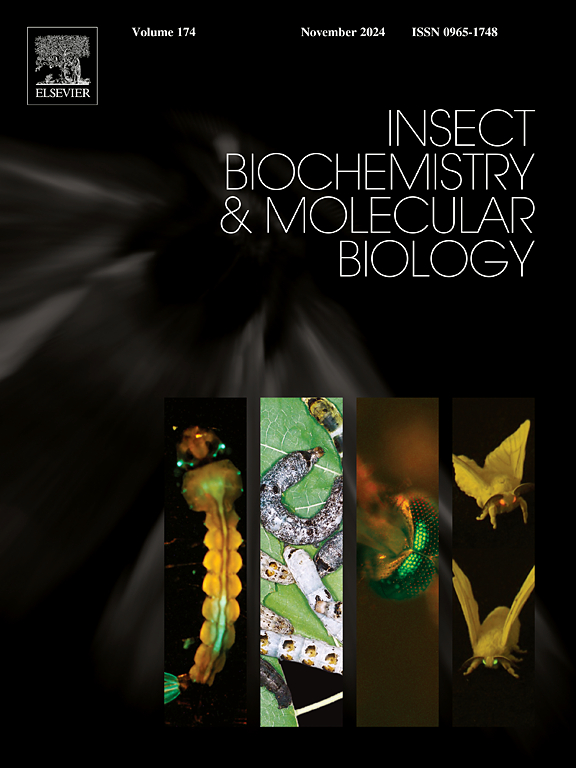Molecular mechanisms based on peripheral level of vanillin recognition in Orthaga achatina (Lepidoptera: Pyralidae)
IF 3.7
2区 农林科学
Q2 BIOCHEMISTRY & MOLECULAR BIOLOGY
引用次数: 0
Abstract
Orthaga achatina (Lepidoptera Pyralidae) is a specialist pest of the camphor tree Cinnamomum camphora. Vanillin is a volatile compound found in many plants, and its effects on insects can be either attractive or repellent, depending on the species. However, the behavioral response of Orthaga achatina to vanillin, a volatile compound emitted by camphor trees, remains unexplored. In this study, we found that vanillin attracts both male and female O. achatina adults. Fluorescence competitive binding assays further revealed that among the five odorant-binding proteins (OBPs) highly expressed in both male and female antennae, OachOBP7 exhibited the most prominent binding affinity with vanillin. Furthermore, by employing the Xenopus oocyte expression and two-electrode voltage clamp recording system (XOE-TEVC) to conduct a functional characterization of 40 ORs, vanillin was the optimal ligand for OachOR7 among all tested ligands. In addition, with the 3D structure modeling and molecular docking techniques, it was revealed that OachOR7 displayed a relatively high binding affinity (−5.5 kcal/mol), and Gln84 and Asn189 were predicted to be key amino acid residues for binding vanillin. Finally, the two amino acids were verified by site-specific mutagenesis followed by XOE-TEVC, showing that the binding ability of OR7 to vanillin was significantly reduced to 9.23 × 10−2 μM after the mutation of two amino acids. This study demonstrate vanillin's behavioral attraction to O. achatina and reveal its molecular basis, offering new possibilities for targeted pest management using this compound.

基于外周水平的香兰素识别分子机制研究(鳞翅目:香兰素科)
樟树树蠹蛾是樟树的特害害虫。香兰素是一种在许多植物中发现的挥发性化合物,它对昆虫的作用可能是吸引或驱避,这取决于昆虫的种类。然而,樟树释放的一种挥发性化合物香兰素对香兰素的行为反应尚不清楚。在这项研究中,我们发现香兰素吸引雄性和雌性O. achatina成虫。荧光竞争结合实验进一步发现,在雄、雌触角均高表达的5种气味结合蛋白(OBPs)中,OachOBP7与香兰素的结合亲和力最为显著。此外,利用爪蟾卵母细胞表达和双电极电压钳记录系统(XOE-TEVC)对40个ORs进行功能表征,在所有测试的配体中,香兰素是OachOR7的最佳配体。此外,通过三维结构建模和分子对接技术,发现OachOR7具有较高的结合亲和力(−5.5 kcal/mol),并预测Gln84和Asn189是结合香兰素的关键氨基酸残基。最后,通过位点特异性诱变和XOE-TEVC验证了这两个氨基酸,结果表明,两个氨基酸突变后,OR7对香兰素的结合能力显著降低至9.23 × 10−2 μM。本研究揭示了香兰素对紫叶虫的行为吸引力,并揭示了其分子基础,为利用该化合物进行害虫的靶向防治提供了新的可能性。
本文章由计算机程序翻译,如有差异,请以英文原文为准。
求助全文
约1分钟内获得全文
求助全文
来源期刊
CiteScore
7.40
自引率
5.30%
发文量
105
审稿时长
40 days
期刊介绍:
This international journal publishes original contributions and mini-reviews in the fields of insect biochemistry and insect molecular biology. Main areas of interest are neurochemistry, hormone and pheromone biochemistry, enzymes and metabolism, hormone action and gene regulation, gene characterization and structure, pharmacology, immunology and cell and tissue culture. Papers on the biochemistry and molecular biology of other groups of arthropods are published if of general interest to the readership. Technique papers will be considered for publication if they significantly advance the field of insect biochemistry and molecular biology in the opinion of the Editors and Editorial Board.

 求助内容:
求助内容: 应助结果提醒方式:
应助结果提醒方式:


